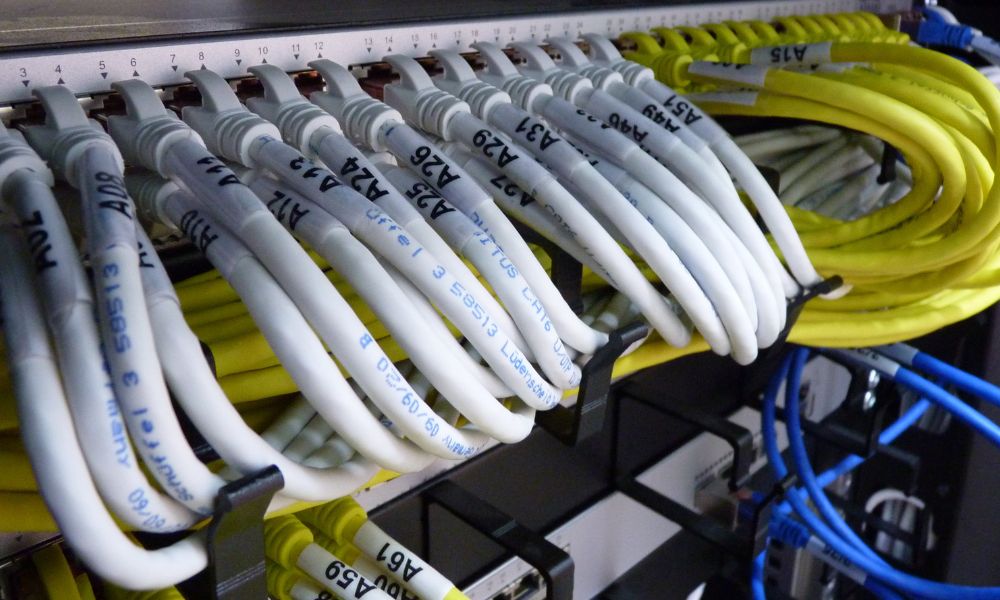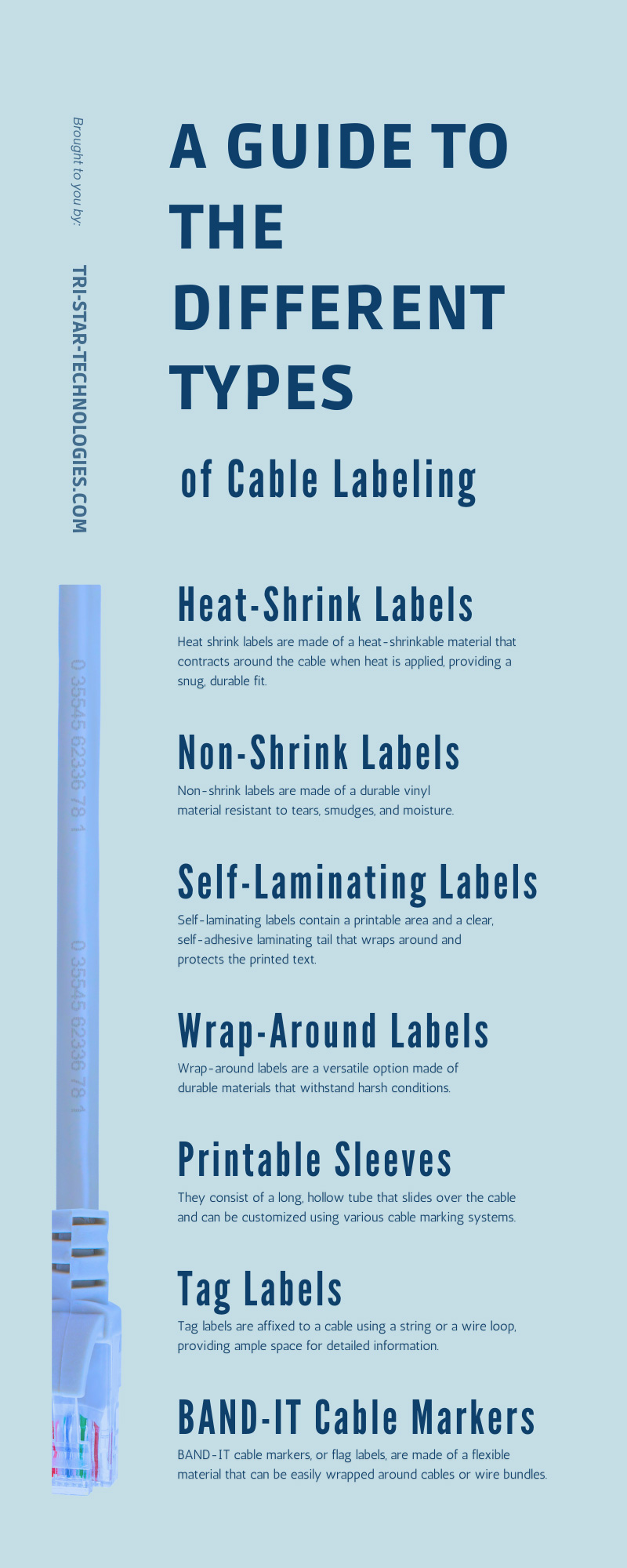A Guide to the Different Types of Cable Labeling

Cable labeling is critical in industries such as pharmaceuticals, research and development, and industrial workplaces where efficient wire management is essential. Proper labeling ensures the reliable identification of cables to prevent errors and facilitate maintenance and troubleshooting. This comprehensive guide will delve into the different types of industrial cable labels and discuss how to choose the best cable and wire labels for your applications.
Types of Industrial Cable Labels
Before we discuss how to choose the ideal cable labeling method for your application, we’ll offer brief descriptions of the most common types of industrial wire labeling, from heat-shrink labels to BAND-IT cable markers.
Heat-Shrink Labels
Heat shrink labels are made of a heat-shrinkable material that contracts around the cable when heat is applied, providing a snug, durable fit. This type of label is highly resistant to abrasion, chemicals, and harsh environments. Heat shrink labels are ideal for applications where durability is paramount, such as in exposed or extreme conditions.
Non-Shrink Labels
Non-shrink labels are made of a durable vinyl material resistant to tears, smudges, and moisture. Unlike heat shrink labels, non-shrink labels do not require heat for application and can easily adhere to the cable’s surface. They are suitable for indoor use and ideal for patch panels, data centers, and other applications where wire identification can change frequently.
Self-Laminating Labels
Self-laminating labels contain a printable area and a clear, self-adhesive laminating tail that wraps around and protects the printed text. This type of label is suitable for environments where cables may be exposed to moisture, chemicals, or UV radiation. With self-laminating labels, the printed information remains clear, readable, and intact over time.
Wrap-Around Labels
Wrap-around labels are a versatile option made of durable materials that withstand harsh conditions. They attach to the cable by wrapping around it, providing a 360-degree view of the label and ensuring easy identification from any angle. These labels are well-suited for applications where the cable may be inaccessible or viewed in areas with limited visibility.
Printable Sleeves
Printable sleeves are a cost-effective alternative to traditional cable labels. They consist of a long, hollow tube that slides over the cable and can be customized using various cable marking systems. Once the sleeve is printed, it is positioned as needed and secured with a fastener. Printable sleeves offer flexibility and ease of use, making them an attractive option for small-scale projects or limited budgets.
Tag Labels
Tag labels are affixed to a cable using a string or a wire loop, providing ample space for detailed information. They are ideal for situations where a cable or wire bundle requires multiple identification points due to complex installations. Tag labels are available in various materials and colors, allowing for a high level of customization to suit specific industry requirements.
BAND-IT Cable Markers
BAND-IT cable markers, or flag labels, are made of a flexible material that can be easily wrapped around cables or wire bundles. These markers come in various sizes and colors, making it easy to create a color-coding system for different types of wires. They are durable and long-lasting, making them suitable for outdoor or rugged environments.
Choosing the Best Cable and Wire Labels for Your Applications
There are many different cable labeling types, but which one is ideal for your application? There are many factors to consider when deciding on a cable label, chief among them being the durability of the label and the material it is made of.
Durability
When choosing cable labels, durability is a crucial factor to consider. Labels exposed to harsh environments or frequent handling require materials resistant to abrasion, chemicals, and extreme temperatures. Non-shrink labels or heat shrink labels are the best options for these scenarios.
Label Material
You should also consider the material of the label. Vinyl labels are popular because they resist moisture, smudging, and tearing. For more durable options, polyester or polyolefin materials may be used.
Gauge Size
Different types of cables have varying thicknesses, which can affect the size and readability of cable labels. Choosing a label size that fits comfortably around the cable without covering important information or becoming illegible due to being too small is important.
Label Placement
Proper label placement is key to effective wire management. Labels should be placed in a visible, accessible location that allows easy identification and avoids interference with other cables or equipment. Labels should be placed near both cable ends to ensure easy tracking.
Readability
Ensure the cable label’s information is easy to read and decipher; this is critical for accurate identification and proper functioning. Choose a label style and font size that ensures readability, even in low-light conditions or for individuals with visual impairments.
Compliance
Regulatory compliance may dictate label specifications in certain industries, such as color coding or symbol requirements. For example, some compliance standards require identifying termination points of both ends of the cable. Select labels that adhere to all relevant industry-specific regulations and guidelines.
Label Size and Bundling
Opt for labels that are the appropriate size for the cable diameter, ensuring a snug fit without being too tight. This is especially important for heat-shrink labels, as they will shrink to the cable’s size when heated. Additionally, consider choosing smaller labels for wire bundles to maintain space efficiency and prevent clutter.
Cost-Effectiveness
Lastly, it is essential to consider the cost of cable labeling solutions as it concerns your project requirements and budget. Some label options may offer higher customization and durability, but they also come at a higher cost. It is crucial to balance the need for functionality with budget constraints.
Conclusion
Various cable labels are available to suit different environments and applications. When selecting cable labeling solutions, it is essential to consider factors such as durability, readability, compliance, and cost-effectiveness to ensure efficient wire management and proper identification. With the right cable labels, you can improve workplace safety, maintenance procedures, and overall productivity.
If you need a reliable wire marking system for cable labeling, look no further than Tri-Star Technologies. With over 30 years of experience in the industry, we offer high-quality and customizable solutions that meet all industry standards and regulations. Our user-friendly software and state-of-the-art printers ensure clear and precise labeling every time. Learn more about our marking systems online or contact our staff If you have any questions.



